Caryn’s Thoughts
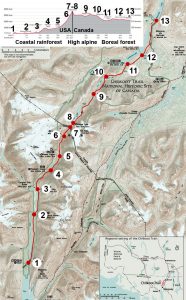 As one who loves to hike, I am always interested in a new trail, whether I will ever get to hike that trail or not. The Chilkoot Trail is a 33 mile trail that travels through the Coast Mountains. The trail travels from Dyea, Alaska, in the United States, to Bennett, British Columbia, in Canada. During the Klondike Gold Rush (1896–1899), the Chilkoot Trail was transformed into a mainstream transportation route to Canada’s interior. The gold rush was primarily focused around Dawson City in Yukon and the Yukon River. While not the easiest trail, the Chilkoot Trail was the most direct, least expensive, and consequently the most popular.
As one who loves to hike, I am always interested in a new trail, whether I will ever get to hike that trail or not. The Chilkoot Trail is a 33 mile trail that travels through the Coast Mountains. The trail travels from Dyea, Alaska, in the United States, to Bennett, British Columbia, in Canada. During the Klondike Gold Rush (1896–1899), the Chilkoot Trail was transformed into a mainstream transportation route to Canada’s interior. The gold rush was primarily focused around Dawson City in Yukon and the Yukon River. While not the easiest trail, the Chilkoot Trail was the most direct, least expensive, and consequently the most popular.
The other primary route, the White Pass route based out of Skagway, was slightly longer but less rigorous and steep, whereas the Chilkoot was shorter and more difficult. Skagway, because of its deepwater harbor, served as the principal port for both routes…nearby Dyea, the beginning of the Chilkoot Trail, was built on the extensive, shallow Taiya River delta. Prospectors who chose the Chilkoot Trail were ferried to Dyea by small boat. The trails turned Skagway and Dyea into bustling tent cities during the gold rush years, which caused men from across the United States to leave their jobs 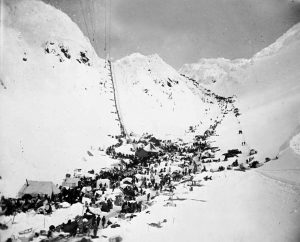 and family to travel up the Inside Passage to Skagway. They had gold on their minds, and the thought of going home rich was all they could think about. Most weren’t successful, and many didn’t make it there or back, but many went.
and family to travel up the Inside Passage to Skagway. They had gold on their minds, and the thought of going home rich was all they could think about. Most weren’t successful, and many didn’t make it there or back, but many went.
I don’t think this would be a trail I would want to be on in the winter, but it might be interesting in the summer months. There are many trails in the world that I would love to hike, but many of them I would probably only hike one time. I always find the history of the many trails that weren’t just for hiking originally, to be very interesting.
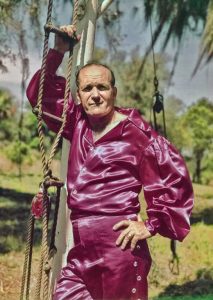 These days, we are all pretty used to stunt people who take wild chances to prove their prowess. It happens all the time. Whether it’s television stunts, circus stunts, or the daredevil stunts, they all have one thing in common…they live to show off their ability to perform these stunts under pressure…even if it costs them their lives, and it has. Many people have heard of Evel Knievel who was famous for jumping his motorcycle over everything. And then there were the car jumps on the Dukes of Hazard. But, really I think the circus was the real beginning of stunts. I could be wrong, but the tight rope walkers and the trapeze stunts, often without a net while a seemingly more tame version of stunt work, were still stunts and still dangerous.
These days, we are all pretty used to stunt people who take wild chances to prove their prowess. It happens all the time. Whether it’s television stunts, circus stunts, or the daredevil stunts, they all have one thing in common…they live to show off their ability to perform these stunts under pressure…even if it costs them their lives, and it has. Many people have heard of Evel Knievel who was famous for jumping his motorcycle over everything. And then there were the car jumps on the Dukes of Hazard. But, really I think the circus was the real beginning of stunts. I could be wrong, but the tight rope walkers and the trapeze stunts, often without a net while a seemingly more tame version of stunt work, were still stunts and still dangerous.
One stuntman, Karl Wallenda, born on January 21, 1905, was a German-American high wire artist, and a member of The Great Wallendas, with whom he began performing at the age of six. His family became a daredevil circus act which performed dangerous stunts, often without a safety net. They soon became world famous, and with fame came more and more difficulty of stunts, and more danger. Their stunts were exclusively high wire, and not trapeze, but they were elaborate and demanded the highest level of skill and bravery. I doubt if any stunt performer really thinks of their own demise very much, but I suppose it is a thought that must enter their minds periodically.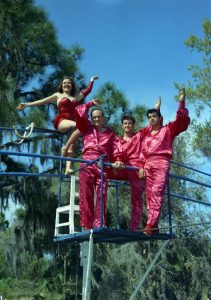
The Great Wallendas were famous throughout Europe for their four-man pyramid and cycling on the high wire. In 1928, Wallenda moved the act to the United States where they became The Flying Wallendas. There they performed in ever-increasingly difficult stunts, as freelancers. In 1947 they developed the unequaled three-tier 7-Man Pyramid. Karl Wallenda had the idea since 1938, but it took until 1946, when he and his brother Hermann developed it and had the right acrobats for it. Prior to that time, the Wallendas had been famous for the four-man pyramid and cycling on the high wire. In 1962, in Detroit, the Wallendas fell during a performance. Two members of the troupe were killed and Karl Wallenda’s son, Mario was paralyzed. Still, after such tragedies, the family determined that the show must always go on, usually after some regrouping. Another performer, Riette fell during a performance in Omaha, Nebraska, and was killed a year after the first tragedy. Karl decided not to continue that part of the act, but his daughter, Carla wanted the act, and after being told no, set out to perform it herself. When he saw her determination, Karl allowed her to have it, and she performed it without mishap. A made-for-TV movie about the family came out in 1978 and starred Karl Wallenda. The movie depicts the act’s comeback after a fatal accident involving several family members during 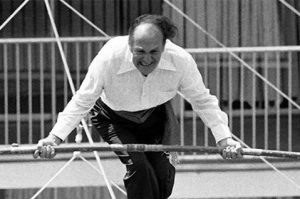 a performance. It looked like the great American comeback, but Wallenda was killed in a high wire accident in just 38 days after it was first broadcast. On March 22, 1978, Wallenda was attempting a walk between the two towers of the ten-story Condado Plaza Hotel in San Juan, Puerto Rico, on a wire stretched 121 feet above the pavement. The winds were high that day, and as a result that, and an improperly secured wire, he lost his balance and fell during the attempt. Wallenda’s face depicts the moment of realization and anguish when he knew that he was doomed. Wallenda was pronounced dead after his body arrived at the hospital. Karl Wallenda was 73 years old.
a performance. It looked like the great American comeback, but Wallenda was killed in a high wire accident in just 38 days after it was first broadcast. On March 22, 1978, Wallenda was attempting a walk between the two towers of the ten-story Condado Plaza Hotel in San Juan, Puerto Rico, on a wire stretched 121 feet above the pavement. The winds were high that day, and as a result that, and an improperly secured wire, he lost his balance and fell during the attempt. Wallenda’s face depicts the moment of realization and anguish when he knew that he was doomed. Wallenda was pronounced dead after his body arrived at the hospital. Karl Wallenda was 73 years old.
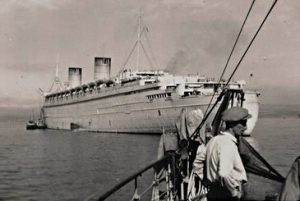 As ocean liners began to be built, sailing the worlds oceans suddenly went from an ordeal that was tolerated in order to improve their lives, to a way to see the world in luxury and relative speed. Emigration to the United States brought with it the need for many great ocean liners, and as they began to appear, the world became mobile. Prior to these ocean liners, it wouldn’t have been possible to really populate the new world. Europe was overcrowded, and the United States was underpopulated. Ocean liners like the Queen Mary, the Mauritania, the Lusitania, the Queen Elizabeth all made travel to the United States and even back to Europe a luxury.
As ocean liners began to be built, sailing the worlds oceans suddenly went from an ordeal that was tolerated in order to improve their lives, to a way to see the world in luxury and relative speed. Emigration to the United States brought with it the need for many great ocean liners, and as they began to appear, the world became mobile. Prior to these ocean liners, it wouldn’t have been possible to really populate the new world. Europe was overcrowded, and the United States was underpopulated. Ocean liners like the Queen Mary, the Mauritania, the Lusitania, the Queen Elizabeth all made travel to the United States and even back to Europe a luxury.
During the world wars, the military commandeered these cruise ships for troop transports, and also for munitions transports. It was not always safe for these ships to be carrying civilian passengers, as was seen with the sinking of the Lusitania, so after a time the cruise ships had to stop their civilian trips and become troop transports exclusively. They had to stop, because whether the ship had munitions on it or not, it was sunk with civilian passengers onboard.
At a time when there were no passenger planes, ocean liners provided the only pathway to cross the oceans. Once war in Europe had begun, many of the great ocean liners of the period withdrew from transatlantic crossings. However, they still remained at sea. Wartime saw ocean liners converted into troopships, carrying thousands of soldiers on a single trip, from bases in the United States to bases in the theaters in Europe, Africa, and Japan. Some of the most famous names in steamship history, including Mauretania, Olympic, Leviathan, 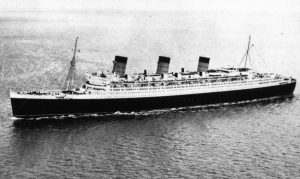 Nieuw Amsterdam (II), Queen Mary and Queen Elizabeth II were among those converted to troopships during times of war. These ships were a critical part of military operations. Without their support, transporting troops, equipment, and munitions would have taken far too long to do any good. These ships were the fastest ships out there at that time in history, and time was of the essence.
Nieuw Amsterdam (II), Queen Mary and Queen Elizabeth II were among those converted to troopships during times of war. These ships were a critical part of military operations. Without their support, transporting troops, equipment, and munitions would have taken far too long to do any good. These ships were the fastest ships out there at that time in history, and time was of the essence.
Of course, these ships faced the threat of submarine or airborne attack, so speed was the greatest defense the ship could have, but they couldn’t just start using the ships. These ships had to go through a process of preparation before they could be a transport ship. All of the items that were not needed for sustaining or berthing the maximum number of troops, were among the first things to go. Furniture, paintings, pianos, and everything else not needed for war would be removed and stored on land, to be returned to the ship after the war was over. The empty space was then filled with hammocks and cots for the soldiers to sleep on. They mounted guns on the decks to provide defensive capability. Of course, these liners could not act as a warship. They were just not designed for that, but a few well placed shots, might deter some of the smaller boats like U-boats from making a surface attack.
Camouflage was considered a critical part of the liners ability to survive in hostile waters. They applied “dazzle paint” to the hulls of these ocean liners. Oddly, the paint closely resembling zebra stripes!! They reasoned that alternating dark and light stripes would obscure the size, speed, heading, and type of ship when viewed from a distance. I can’t picture that exactly, and apparently it wasn’t very effective either. I guess all that it really did 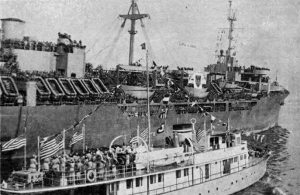 was to give a false sense of security to the soldiers on board.
was to give a false sense of security to the soldiers on board.
Following the war, and ship that survived their wartime duties was restored to its former look and feel so that it could continue with its pre-war duties. Unfortunately, many of these beautiful ocean liners were lost to enemy fire during the war. Sadly, there are no real examples of these wartime liners turned troop transports, but the Queen Mary is in dry dock in Long Beach, California. Visitors can take a tour, and get a real feel for those cramped quarters. Visitors can imagine the soldiers felt as they crossed the North Atlantic, knowing that their ship was a prized target for the enemy.
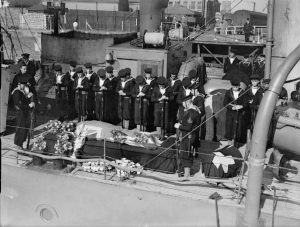
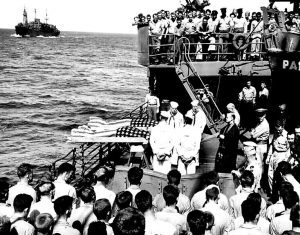 Most of us really don’t want to think about our own funeral, but when men are at war, death and a funeral become a subject they have to think about. They don’t want to, but they have no guarantee that they will return home, so they are faced with the possibility of death every day. In the Navy, during wartime, at least in the past, if not currently, it was common practice to bury the casualties at sea. That is such a hard concept for me, and yet there isn’t really anything wrong with it. I guess that having no grave site to visit is probably the thing that is bothering me the most. It’s not that I spend days and hours at the cemetery, but rather that I know exactly where my loved ones are laid to rest, or where I will be.
Most of us really don’t want to think about our own funeral, but when men are at war, death and a funeral become a subject they have to think about. They don’t want to, but they have no guarantee that they will return home, so they are faced with the possibility of death every day. In the Navy, during wartime, at least in the past, if not currently, it was common practice to bury the casualties at sea. That is such a hard concept for me, and yet there isn’t really anything wrong with it. I guess that having no grave site to visit is probably the thing that is bothering me the most. It’s not that I spend days and hours at the cemetery, but rather that I know exactly where my loved ones are laid to rest, or where I will be.
Burials at sea have been going on as long as men have been going to sea. For logical reasons, a body could not be kept on board a ship for the remainder of the cruise, so the death had to be dealt with. In early days, the body was wrapped in a shroud, usually made of sailcloth, but later caskets were also used. If the family has decided to use a casket instead of a shroud for the burial at sea, the casket must be a metal casket, because it must be able to deteriorate in the marine environment. I suppose that makes sense, because eventually ships and planes return to the environment around them. The sea eventually claims what doesn’t belong there naturally. Of course, the timeframe involved in the deterioration of the casket would be well beyond the lifetime of the families, so I guess that would make it easier to think about it.
Military burials at sea are performed with much pomp and circumstance. The honor of the soldier is held in the highest regard. The personnel who participate or even attend the services must wear the Uniform of the Day. The commanding officer tries to have a chaplain of the appropriate faith perform the ceremony, but if that is not an option, the service may be read by the commanding officer or an officer designated by him/her. The service is much like a church service, with a eulogy, firing squad salute, pall bearers, and a flag ceremony. When everything is finished, the body is moved to the side of the ship of a plank and then the plank is raised so that the casket or shrouded body slides off into the sea.
Of course, when a ship sinks, there is an instant burial at sea for all who do not survive. Many times the ship is not found for years, so the ship becomes the casket for all those who lost their lives. The family can seek to have the body recovered when the ship is found, but often that does not happen. The USS Arizona is probably 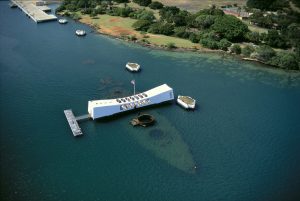
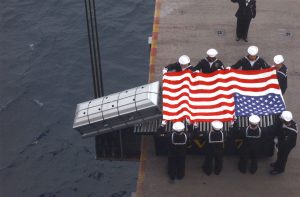 one of the most well known casket ships in the world, and while it was easy to see and get to, many of the families chose to leave their loved ones there. The USS Arizona went down with 1,177 Sailor and Marines on board. The ship marks the final resting spot of 1,102 of the original 1,177. Also, beginning in 1982, the US Navy has allowed surviving crew members to be “buried” on the Arizona.
one of the most well known casket ships in the world, and while it was easy to see and get to, many of the families chose to leave their loved ones there. The USS Arizona went down with 1,177 Sailor and Marines on board. The ship marks the final resting spot of 1,102 of the original 1,177. Also, beginning in 1982, the US Navy has allowed surviving crew members to be “buried” on the Arizona.
 Since man had power on the earth, man has also had power outages. Power outages are one thing, but rolling blackouts are another thing altogether. “A rolling blackout, also known as rotational load shedding, feeder rotation, or a rotating outage is an intentionally-engineered electrical power shutdown in which electricity delivery is stopped for non-overlapping periods of time over different parts of the distribution region.” This type of shutdown…rolling blackouts…are a supposed to be a last-resort measure used by an electric utility company to avoid a total blackout of the power system. I can understand that in a serious heat wave, even though it is a dangerous maneuver, and I can even understand it in an overload caused by an unexpected cold snap, even thought that is also seriously dangerous.
Since man had power on the earth, man has also had power outages. Power outages are one thing, but rolling blackouts are another thing altogether. “A rolling blackout, also known as rotational load shedding, feeder rotation, or a rotating outage is an intentionally-engineered electrical power shutdown in which electricity delivery is stopped for non-overlapping periods of time over different parts of the distribution region.” This type of shutdown…rolling blackouts…are a supposed to be a last-resort measure used by an electric utility company to avoid a total blackout of the power system. I can understand that in a serious heat wave, even though it is a dangerous maneuver, and I can even understand it in an overload caused by an unexpected cold snap, even thought that is also seriously dangerous.
I don’t know a lot about the energy industry, but I do know that some of the recent cuts in types of energy resources are very dangerous when it comes to making sure that we have enough energy for our country. It  seems that these states who don’t regularly need large amounts of energy for heating and cooling, don’t have a way to “stockpile” any either. Rolling blackouts are used as a response strategy to cope with reduced output beyond reserve capacity from power stations taken offline unexpectedly, such as an extreme weather event. So, when an emergency occurs, their solution is to have these rolling blackouts. California has done this for years.
seems that these states who don’t regularly need large amounts of energy for heating and cooling, don’t have a way to “stockpile” any either. Rolling blackouts are used as a response strategy to cope with reduced output beyond reserve capacity from power stations taken offline unexpectedly, such as an extreme weather event. So, when an emergency occurs, their solution is to have these rolling blackouts. California has done this for years.
The theory behind the rolling blackouts is a “measure of demand” response. If the demand for electricity exceeds the power supply capability of the network, it’s time to have a planned blackout. Rolling blackouts might be limited to a single city or state, or they can be district or nationwide. The whole thing depends on the network and the stockpile of energy resources. Rolling blackouts generally result from two causes. These are insufficient generation capacity or inadequate transmission infrastructure to deliver power to where it is needed.
For California the rolling blackouts had began on June 14th, 2000 due to a heatwave. Other dates for rolling blackouts in those first couple of years were January 17-18, 2001, March 19-20, 2001, and May 7-8, 2001. These were the beginning dates of the California electricity crisis which included extremely high prices and  rolling blackouts. In reality, the “crisis” was a direct result from the manipulation of energy of a partially deregulated California energy system by companies like Enron and Reliant Energy. I wonder too, if the mismanagement wasn’t also on the part of the state’s mismanagement. The recent power outages in Texas from the freezing weather were also rolling blackouts, and the problems they caused were far worse than the California rolling blackouts, because of all the things that froze up from the severe cold. The reality is that one way or the other, our government has to stop limiting the production of our energy resources. That is my opinion, and I’m sure some would disagree, but these rolling blackouts are ridiculous.
rolling blackouts. In reality, the “crisis” was a direct result from the manipulation of energy of a partially deregulated California energy system by companies like Enron and Reliant Energy. I wonder too, if the mismanagement wasn’t also on the part of the state’s mismanagement. The recent power outages in Texas from the freezing weather were also rolling blackouts, and the problems they caused were far worse than the California rolling blackouts, because of all the things that froze up from the severe cold. The reality is that one way or the other, our government has to stop limiting the production of our energy resources. That is my opinion, and I’m sure some would disagree, but these rolling blackouts are ridiculous.
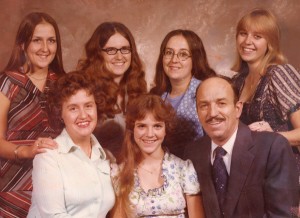
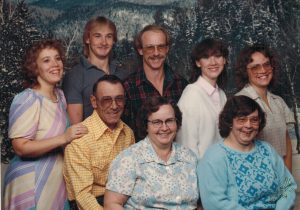 Have you ever wondered what things you might change if you could just turn back time? I can think of a number of things I would change, and I can think of many things that I would never change too. Things like my husband, children, grandchildren, and great grandchildren are definitely in the “I wouldn’t change these things at all” category. My religious beliefs and career choices fall in that category as well. I have lived a blessed life. Of that fact there is not doubt. I had wonderful parents and in-laws, as well as sisters, sisters-in-law and brothers-in-law, nieces, and nephews too. My aunts, uncles, and cousins are precious to me. Yes, I have been greatly blessed. In these things, I would never choose to turn back time.
Have you ever wondered what things you might change if you could just turn back time? I can think of a number of things I would change, and I can think of many things that I would never change too. Things like my husband, children, grandchildren, and great grandchildren are definitely in the “I wouldn’t change these things at all” category. My religious beliefs and career choices fall in that category as well. I have lived a blessed life. Of that fact there is not doubt. I had wonderful parents and in-laws, as well as sisters, sisters-in-law and brothers-in-law, nieces, and nephews too. My aunts, uncles, and cousins are precious to me. Yes, I have been greatly blessed. In these things, I would never choose to turn back time.
Of course, we have all made mistakes in life. I think the ones that tend to haunt us the most are the things we didn’t say, when we could have. Or we might regret the things we did say, when we might have kept quiet, or said something different. Also, we might regret the time we might have spent with those we care about, but we allowed our busy lives to dictate our time, or the lack thereof. When it pertains to those we love, like parents, grandparents, aunts, or uncles, we all have wished that we had spent more time. Of course, as kids, and even as adults, there always seemed to be more time for these things later…until there wasn’t. When they are gone, we finally see just how unimportant that important thing we needed to do, really was. Of course, communication goes both ways, but some people really warrant an extra effort. Unfortunately, they don’t always let us know that they needed more of our time. They don’t want to intrude, I suppose.
If I could turn back time, I would go see my parents and in-laws more than I did. I would call and talk to siblings, siblings-in-law, nieces, nephews, aunts, uncles, and cousins more. I have found that for those who are online, Facebook, texting, and Messenger have helped to fill the gaps. For me, it is far easier to text or write things down, because believe it or not, I am a bashful person. I can carry on a conversation, however, and I 
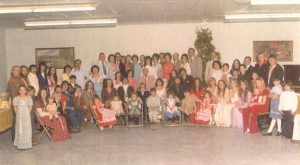 really should do that, so I don’t regret still another “shoulda, woulda, coulda” later in my life. I guess what I am getting at is that we all need to consider the things that are important to us, and make sure that we pay those important things enough attention. That way, maybe, “If I could turn back time” could be just another song lyrics, and not a personal regret.
really should do that, so I don’t regret still another “shoulda, woulda, coulda” later in my life. I guess what I am getting at is that we all need to consider the things that are important to us, and make sure that we pay those important things enough attention. That way, maybe, “If I could turn back time” could be just another song lyrics, and not a personal regret.

 Most days in our lives are normal…ordinary. We get up, go to work, cook meals, got to sleep. It’s all ordinary, and it could be boring, if we let it. I suppose that might be why we have a few special days that are all about fun. Saint Patrick’s Day is one of those days…at least in the United States. Here it is party day. The day of green beer, and a green Chicago River. It a day of wearing green, and getting pinched if you forget. It’s a day for green fingernails and green hair. It’s really just a day to party and have fun. There has to be a few of those kinds of days in life, or it all gets too dull.
Most days in our lives are normal…ordinary. We get up, go to work, cook meals, got to sleep. It’s all ordinary, and it could be boring, if we let it. I suppose that might be why we have a few special days that are all about fun. Saint Patrick’s Day is one of those days…at least in the United States. Here it is party day. The day of green beer, and a green Chicago River. It a day of wearing green, and getting pinched if you forget. It’s a day for green fingernails and green hair. It’s really just a day to party and have fun. There has to be a few of those kinds of days in life, or it all gets too dull.
Saint Patrick’s Day always reminds me of Spring, which is just a few days away. I suppose that is the main reason…that and wearing green. The days are getting longer, and normally 
 there is less snow. This year seems a little more like April Fools Day to me, however. With a record snowfall of over 26″ and up to 38″ in Colorado, 2,300 flights were cancelled, and pretty much everything was shut down. People began to dig out of their homes and driveways, but where would they go then? The joke was definitely on all of us, but that is a story for another day, say…April Fools Day.
there is less snow. This year seems a little more like April Fools Day to me, however. With a record snowfall of over 26″ and up to 38″ in Colorado, 2,300 flights were cancelled, and pretty much everything was shut down. People began to dig out of their homes and driveways, but where would they go then? The joke was definitely on all of us, but that is a story for another day, say…April Fools Day.
Of course, Saint Patrick’s Day was made an official Christian feast day in the early 17th century and is observed by the Catholic Church, the Anglican Communion (especially the Church of Ireland), the Eastern Orthodox Church, and the Lutheran Church. It is the day that commemorates Saint Patrick and the arrival of Christianity  in Ireland, and celebrates the heritage and culture of the Irish in general. Celebrations generally involve public parades and festivals, dances, and the wearing of green attire or shamrocks. It is also a time when Christians who belong to liturgical denominations attend church services and historically the Lenten restrictions on eating and drinking alcohol were lifted for the day, which has encouraged and propagated the holiday’s tradition of alcohol consumption. That the day is tied to the church is not surprising, but the fact that the day is far more celebrated in the United States than it is in Ireland, is at the very least, a little bit strange. Nevertheless, for all who celebrate, Happy Saint Paddy’s Day!!
in Ireland, and celebrates the heritage and culture of the Irish in general. Celebrations generally involve public parades and festivals, dances, and the wearing of green attire or shamrocks. It is also a time when Christians who belong to liturgical denominations attend church services and historically the Lenten restrictions on eating and drinking alcohol were lifted for the day, which has encouraged and propagated the holiday’s tradition of alcohol consumption. That the day is tied to the church is not surprising, but the fact that the day is far more celebrated in the United States than it is in Ireland, is at the very least, a little bit strange. Nevertheless, for all who celebrate, Happy Saint Paddy’s Day!!
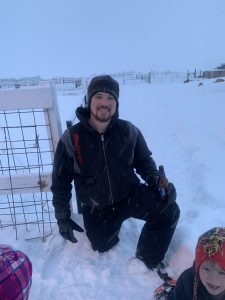
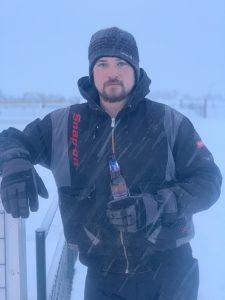 My nephew, Eric Parmely has changed so much over the years. I find myself amazed at the life he lives today. Eric is husband to Ashley, and daddy to Reagan, Hattie, Bowen, and Maeve. That’s his human family anyway. Eric and Ashley own a little ranch west of Casper, where they raise children, dogs, cats, goats, horses, turkeys, cows, ducks, pigs, and maybe others that I have not mentioned. There are always new babies on the ranch, and those animal babies are just as much a part of the family too. I can’t imagine all those babies in the family, but Eric and Ashley love each and every one of them. Of course, they and the children also understand that some animals are for food, and that is just how it has to be. The constants in the family of animal members, of course are the horses, cats, and dogs. They will never be food, as we all know. They are, and always will be pets.
My nephew, Eric Parmely has changed so much over the years. I find myself amazed at the life he lives today. Eric is husband to Ashley, and daddy to Reagan, Hattie, Bowen, and Maeve. That’s his human family anyway. Eric and Ashley own a little ranch west of Casper, where they raise children, dogs, cats, goats, horses, turkeys, cows, ducks, pigs, and maybe others that I have not mentioned. There are always new babies on the ranch, and those animal babies are just as much a part of the family too. I can’t imagine all those babies in the family, but Eric and Ashley love each and every one of them. Of course, they and the children also understand that some animals are for food, and that is just how it has to be. The constants in the family of animal members, of course are the horses, cats, and dogs. They will never be food, as we all know. They are, and always will be pets.
Eric is a hard working man. He has a regular job, and then comes home and works hard on the ranch. He and Ashley bought a tractor that he is been fixing up. Once it is in good shape, it will be a big help to him on the ranch. There is much work to do on a ranch and a rancher needs the right tools. This tractor will put them closer to having all the tools they need. They live on a dirt road, so they need to be able to clear roads and so much more. Tractors and ranches just go together.
Eric has discovered audio books. To me that is vital. With our busy lives, finding time to read a book is almost impossible, but we can listen to our books while we work. Eric likes a variety of books, and just finished Harry Potter. I’m not into the Harry Potter stuff, but I love to listen to World War II books. To each his own, I guess. I find that audiobooks have broadened my horizons, and I have other types of books I have listened to since I started with Audible. Eric will most likely be the same.
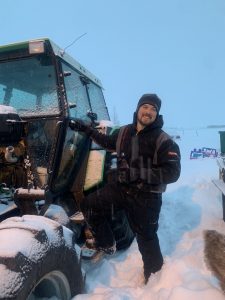
Eric, being the dad of young kids, has had to keep up with all their activities. I saw a video recently of Eric trying to skateboard. He did pretty good, but I’m sure that the kids, especially Reagan can out-do him. It’s simply an age thing, so it would make sense for her to be better at it than her dad, but I could be wrong. I have been known to be wrong about such things, after all. Eric has recently discovered iced vanilla lattes and has switched to decaf coffee. Now, that part is odd to me, because he probably need more caffeine kick, not less to keep up with his busy lifestyle. More power to him if he can do it caffeine-free. Today is Eric’s birthday. Happy birthday Eric!! Have a great day!! We love you!!

 My niece, Kellie Hadlock is a wonderful girl, who is always the happiest person around you. I don’t know how she does it, except that she has kept happiness in her spirit all her life. It was a top priority. She has giggled her way through life, and passed her giggles on to everyone she knows. She is a great joy to be around. She has been a great blessing to her family, especially her nephew, Ethan Hadlock, and nieces, Aurora Hadlock, Adelaide Sawdon, and Mackenzie Moore, all of whom love her to pieces. Kellie is a wonderful aunt, and loves to play with the kids. They totally enjoy being with her. She hangs out with her brother, Ryan Hadlock and sisters, Jessi Sawdon, Lindsay Moore and their spouses, Chelsea Hadlock, Jason Sawdon, and Shannon Moore a lot, and the whole family gets together as often as they can.
My niece, Kellie Hadlock is a wonderful girl, who is always the happiest person around you. I don’t know how she does it, except that she has kept happiness in her spirit all her life. It was a top priority. She has giggled her way through life, and passed her giggles on to everyone she knows. She is a great joy to be around. She has been a great blessing to her family, especially her nephew, Ethan Hadlock, and nieces, Aurora Hadlock, Adelaide Sawdon, and Mackenzie Moore, all of whom love her to pieces. Kellie is a wonderful aunt, and loves to play with the kids. They totally enjoy being with her. She hangs out with her brother, Ryan Hadlock and sisters, Jessi Sawdon, Lindsay Moore and their spouses, Chelsea Hadlock, Jason Sawdon, and Shannon Moore a lot, and the whole family gets together as often as they can.
Kellie works at American Title and is well liked by bosses and coworkers alike. Kellie is a hard worker, who 
 works carefully and accurately. She also decided to buy a house recently, and she really loves it. She lives there with her Yorkie dog, Leena and her birds…her pets. Kellie stays active and goes to the gym a lot. One of her favorite things to do is to sing at church. She loves singing! I think that when she is singing, Kellie is at her most happy. The nice thing about singing is that she can be happy about life, and singing still fits right in. Kellie has a beautiful voice, and is such a great part of our church worship team. Her solos and her lead singing parts are stunning. Many people would love to have a voice like Kellie’s.
works carefully and accurately. She also decided to buy a house recently, and she really loves it. She lives there with her Yorkie dog, Leena and her birds…her pets. Kellie stays active and goes to the gym a lot. One of her favorite things to do is to sing at church. She loves singing! I think that when she is singing, Kellie is at her most happy. The nice thing about singing is that she can be happy about life, and singing still fits right in. Kellie has a beautiful voice, and is such a great part of our church worship team. Her solos and her lead singing parts are stunning. Many people would love to have a voice like Kellie’s.
Last year, Kellie met Tim Thompson, and they are very happy together. They get along so well and Tim really fits into her family. They are so compatible, enjoying many of the same things, but there are other activities that Tim has introduced Kellie to that are new to her. He takes her hunting, and to the indoor shooting range, which she really likes. They go hiking, snow shoeing, and just love being together. He comes to Casper as often 
 as he can from Gillette and they have a lot of fun. She has her little dog Leena, who is just a tiny bundle of energy and Tim has a golden retriever named Jet, who loves Kellie and Leena. The difference in these two dogs could not be greater, but Jet is so gentle, and Leena doesn’t feel afraid at all. Tim also has a daughter named Jolene, and she is very sweet. She and Kellie get along great too. Tim has taught Kellie a lot about cooking, because he loves to cook and the whole family has benefited from his culinary skills. Tim is so good to Kellie. For her birthday he bought her a guitar, a gift which she is just thrilled with. With her love of singing, a guitar is just perfect for her. Today is Kellie’s birthday. Happy birthday Kellie!! Have a great day!! We love you!!
as he can from Gillette and they have a lot of fun. She has her little dog Leena, who is just a tiny bundle of energy and Tim has a golden retriever named Jet, who loves Kellie and Leena. The difference in these two dogs could not be greater, but Jet is so gentle, and Leena doesn’t feel afraid at all. Tim also has a daughter named Jolene, and she is very sweet. She and Kellie get along great too. Tim has taught Kellie a lot about cooking, because he loves to cook and the whole family has benefited from his culinary skills. Tim is so good to Kellie. For her birthday he bought her a guitar, a gift which she is just thrilled with. With her love of singing, a guitar is just perfect for her. Today is Kellie’s birthday. Happy birthday Kellie!! Have a great day!! We love you!!


 Sometimes, the “best laid plans” turn into the biggest unplanned event. Bob and I take a trip to Thermopolis, Wyoming each year to celebrate our anniversary. Thermopolis is a dinky little town with very little to do, except that it has amazing hot springs she that adds up to great mineral water soaks that are terrific for the body. We also take wonderful walks along the trail that is set up on the Bighorn River, which flows through town. It is a peaceful tradition that we love to continue. Nevertheless, sometimes life can throw you a curve ball.
Sometimes, the “best laid plans” turn into the biggest unplanned event. Bob and I take a trip to Thermopolis, Wyoming each year to celebrate our anniversary. Thermopolis is a dinky little town with very little to do, except that it has amazing hot springs she that adds up to great mineral water soaks that are terrific for the body. We also take wonderful walks along the trail that is set up on the Bighorn River, which flows through town. It is a peaceful tradition that we love to continue. Nevertheless, sometimes life can throw you a curve ball.
Bob and I have both been snowed in during our lifetimes, but this storm was still something new to us, because 

 we are not snowed in. We are snowed out!!! Thermopolis got no snow at all, only a sprinkling of rain, but in Casper, which is home, it is a very different story. I have see n measurements of 18″ to 24″, and I’m sure it could be more by now. The roads in and out of Casper are closed, and since we are in Thermopolis, where there is no snow, we are not snowed in, but we are snowed out of Casper. It is a matter of the fact that you can’t get there from here…at least not today.
we are not snowed in. We are snowed out!!! Thermopolis got no snow at all, only a sprinkling of rain, but in Casper, which is home, it is a very different story. I have see n measurements of 18″ to 24″, and I’m sure it could be more by now. The roads in and out of Casper are closed, and since we are in Thermopolis, where there is no snow, we are not snowed in, but we are snowed out of Casper. It is a matter of the fact that you can’t get there from here…at least not today.
I can’t say that I am exactly heartbroken about having to stay at least an extra day in Thermopolis. In fact, I’m hoping that a lot of the snow will melt before we get home. That would simply not hurt my feelings one bit. I have been talking to my sisters, Cheryl Masterson, Alena Stevens, and Allyn Hadlock; and my daughter, Corrie Petersen and grandson, Chris Petersen in Casper; and one sister, Caryl Reed in Rawlins, and they have graciously provided me with what I cannot see here. Tons and tons of snow!! The pictures of all the work trying to dig out, and the futility of such a venture in most cases, are shocking. It’s hard for me to fathom 

 the amount of snow from here, but I can say that it is massive. Even my niece, Lindsay Moore in Laramie, and my nieces, Liz Masterson, and Jenny Spethman in Casper, have added to the amount of pictures that have told the story of this huge snow day. It is truly a kid’s dream, and for those who couldn’t go to work today and won’t be tomorrow, it isn’t the most horrible news either.
the amount of snow from here, but I can say that it is massive. Even my niece, Lindsay Moore in Laramie, and my nieces, Liz Masterson, and Jenny Spethman in Casper, have added to the amount of pictures that have told the story of this huge snow day. It is truly a kid’s dream, and for those who couldn’t go to work today and won’t be tomorrow, it isn’t the most horrible news either.

